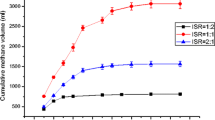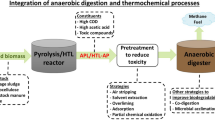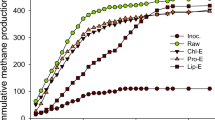Abstract
Converting lipid-extracted microalgal wastes to methane (CH4) via anaerobic digestion (AD) has the potential to make microalgae-based biodiesel platform more sustainable. However, it is apparent that remaining n-hexane (C6H14) from lipid extraction could inhibit metabolic pathway of methanogens. To test an inhibitory influence of residual n-hexane, this study conducted a series of batch AD by mixing lipid-extracted Chlorella vulgaris with a wide range of n-hexane concentration (∼10 g chemical oxygen demand (COD)/L). Experimental results show that the inhibition of n-hexane on CH4 yield was negligible up to 2 g COD/L and inhibition to methanogenesis became significant when it was higher than 4 g COD/L based on quantitative mass balance. Inhibition threshold was about 4 g COD/L of n-hexane. Analytical result of microbial community profile revealed that dominance of alkane-degrading sulfate-reducing bacteria (SRB) and syntrophic bacteria increased, while that of methanogens sharply dropped as n-hexane concentration increased. These findings offer a useful guideline of threshold n-hexane concentration and microbial community shift for the AD of lipid-extracted microalgal wastes.





Similar content being viewed by others
References
APHA (1998) Standard methods for the examination of water and wastewater. American Public Health Association, US
Chisti Y (2007) Biodiesel from microalgae. Biotechnol Adv 25:294–306
Cole JR, Wang Q, Cardenas E et al (2009) The ribosomal database project: improved alignments and new tools for rRNA analysis. Nucleic Acids Res 37(D1):141–145
Cooney M, Young G, Nagle N (2009) Extraction of bio‐oils from microalgae. Sep Purif Rev 38:291–325
Delong EF (1992) Archaea in coastal marine environment. P Natl A Sci India A USA 89:5685–5689
Demirel B, Scherer P (2008) The roles of acetotrophic and hydrogenotrophic methanogens during anaerobic conversion of biomass to methane: a review. Rev Environ Sci Bio 7:173–190
Halim R, Gladman B, Danquah MK et al (2011) Oil extraction from microalgae for biodiesel production. Bioresour Technol 102:178–185
Kavitha S, Jayashree C, Kumar SA et al (2014a) The enhancement of anaerobic biodegradability of waste activated sludge by surfactant mediated biological pretreatment. Bioresour Technol 168:159–166
Kavitha S, Jayashree C, Kumar SA et al (2014b) Enhancing the functional and economical efficiency of a novel combined thermo chemical disperser disintegration of waste activated sludge for biogas production. Bioresour Technol 173:32–41
Kim DH, Jang S, Yun YM et al (2014) Effect of acid-pretreatment on hydrogen fermentation of food waste: microbial community analysis by next generation sequencing. Int Int J Hydrog Energy 39:16302–16309
Lakaniemi AM, Tuovinen OH, Puhakka JA (2013) Anaerobic conversion of microalgal biomass to sustainable energy carriers—a review. Bioresour Technol 135:222–231
Lay J, Lee Y, Noike T (1999) Feasibility of biological hydrogen production from organic fraction of municipal solid waste. Water Res 33:2579–2586
Lay J, Li Y, Noike T (1997) Influences of pH and moisture content on the methane production in high-solids sludge digestion. Water Res 31:1518–1524
Li W, Fu L, Niu B et al (2012) Ultrafast clustering algorithms for metagenomic sequence analysis. Brief Bioinform 13:656–668
Lim JW, Lim PE, Seng CE et al (2014) Alternative solid carbon source from dried attached-growth biomass for nitrogen removal enhancement in intermittently aerated moving bed sequencing batch reactor. Environ Sci Pollut R 21:485–494
Nguyen H (2012) Biogas production from solvent pretreated orange peel. Thesis for Master of Science Chalmers University of Technology
Overas L, Forney L, Daae FL et al (1997) Distribution of bacterioplankton in meromictic Lake Saelenvannet, as determined by denaturing gradient gel electrophoresis of PCR-amplified gene fragments coding for 16S rRNA. Appl Environ Microb 63:3367–3373
Pires JCM, Alvim-Ferraz MCM, Martins FG et al (2013) Wastewater treatment to enhance the economic viability of microalgae culture. Environ Sci Pollut R 20:5096–5105
Rani RU, Kumar SA, Kaliappan S et al (2014) Enhancing the anaerobic digestion potential of dairy waste activated sludge by two step sono-alkalization pretreatment. Ultrason Sonochem 21:1065–1074
Schloss PD, Westcott SL, Ryabin T et al (2009) Introducing mothur: open-source, platform independent, community-supported software for describing an comparing microbial communities. Appl Environ Microb 75:7537–7541
Sheng J, Vannela R, Rittmann BE (2011) Evaluation of methods to extract and quantify lipids from Synechocystis PCC 6803. Bioresour Technol 102:1697–1703
Siddique T, Penner T, Semple K et al (2011) Anaerobic biodegradation of longer-chain n-alkanes coupled to methane production in oil sands tailings. Environ Sci Technol 45:5892–5899
Stams AJ, Plugge CM (2009) Electron transfer in syntrophic communities of anaerobic bacteria and archaea. Nat Rev Microbiol 7:568–577
Van Kuijk BL, Stams AJ (1995) Sulfate reduction by a syntrophic propionate-oxidizing bacterium. Anton Leeuw Int J G 68:293–296
Widdel F, Rabus R (2001) Anaerobic biodegradation of saturated and aromatic hydrocarbons. Curr Opin Biotech 12:259–276
Yang Q, Ren S, Niu T et al (2014) Distribution of antibiotic-resistant bacteria in chicken manure and manure-fertilized vegetables. Environ Sci Pollut R 21:1231–1241
Yun YM, Kim DH, Oh YK et al (2014) Application of a novel enzymatic pretreatment using crude hydrolytic extracellular enzyme solution to microalgal biomass for dark fermentative hydrogen production. Bioresour Technol 159:365–372
Acknowledgments
This research was supported by a grant from a Strategic Research Project (Water Reuse Technology for Smart Water Micro-Grids, Code# 2014-0020-1-1) funded by the Korea Institute of Civil Engineering and Building Technology and by a grant (code 13IFIP-B065893-01) from Industrial Facilities & Infrastructure Research Program funded by the Ministry of Land, Infrastructure and Transport of the Korean government. In addition, this paper was supported by research funds of Chonbuk National University in 2014.
Author information
Authors and Affiliations
Corresponding author
Additional information
Responsible editor: Gerald Thouand
Rights and permissions
About this article
Cite this article
Yun, YM., Shin, HS., Lee, CK. et al. Inhibition of residual n-hexane in anaerobic digestion of lipid-extracted microalgal wastes and microbial community shift. Environ Sci Pollut Res 23, 7138–7145 (2016). https://doi.org/10.1007/s11356-015-4643-z
Received:
Accepted:
Published:
Issue Date:
DOI: https://doi.org/10.1007/s11356-015-4643-z




